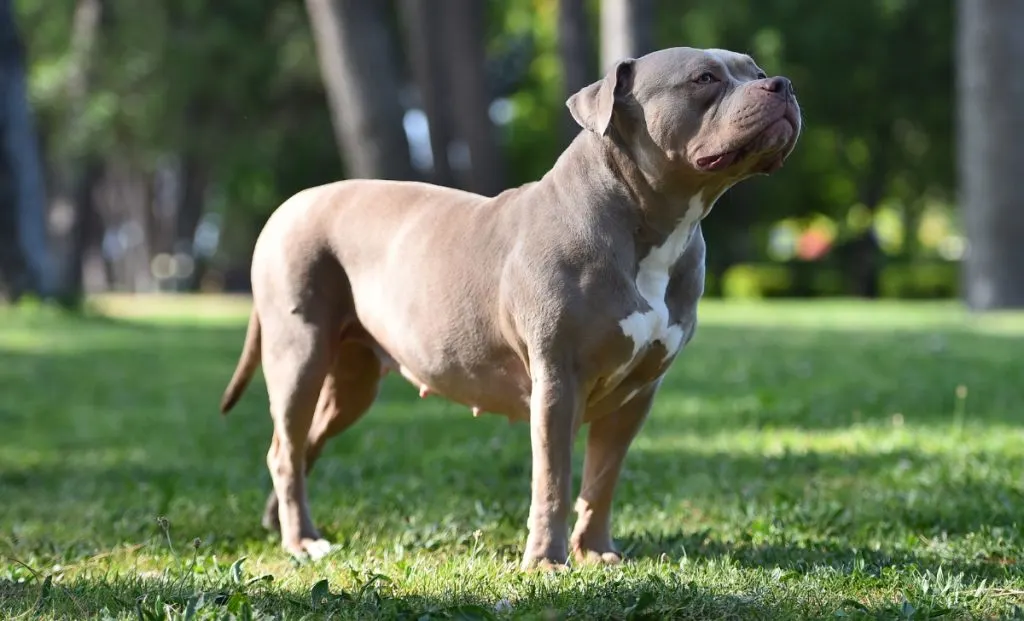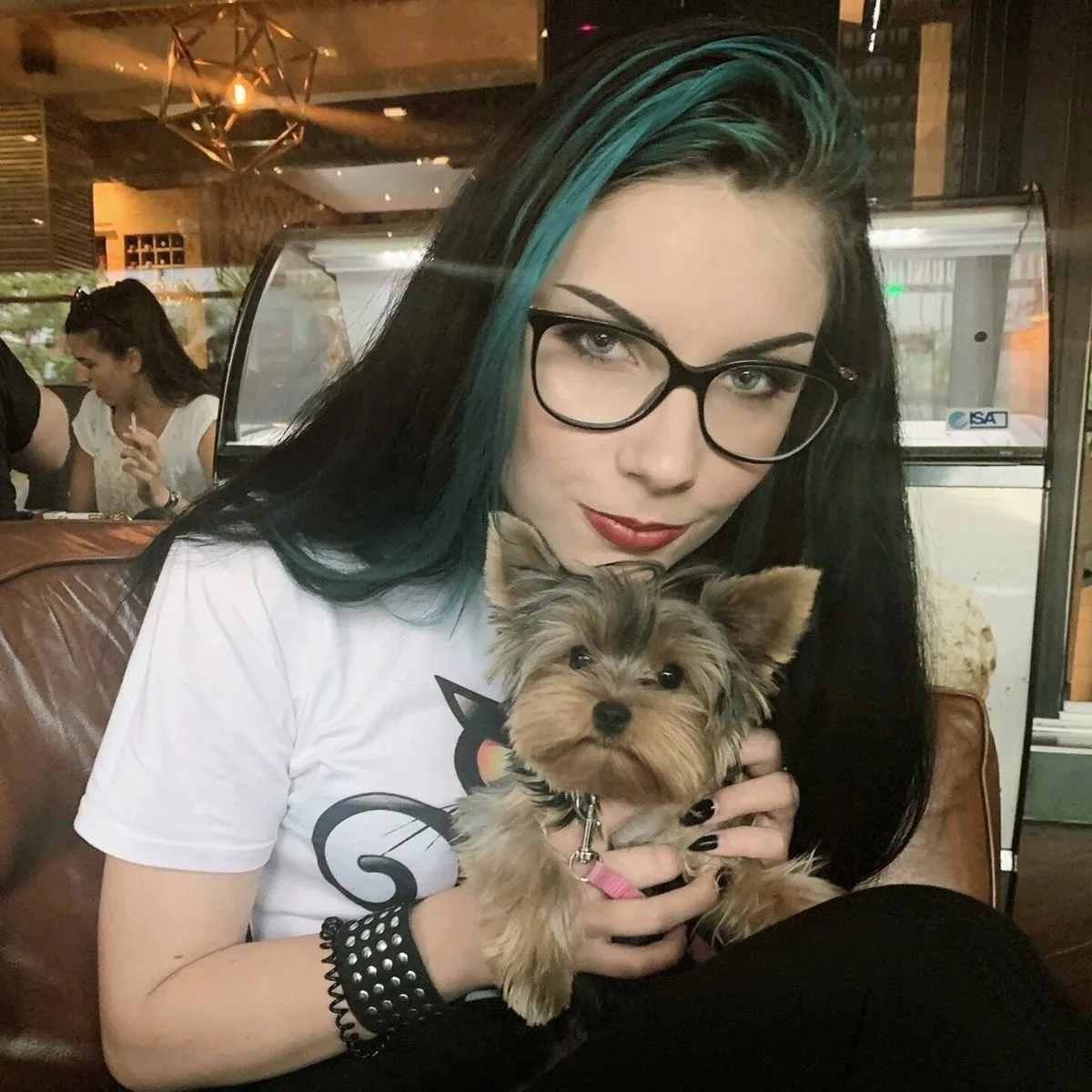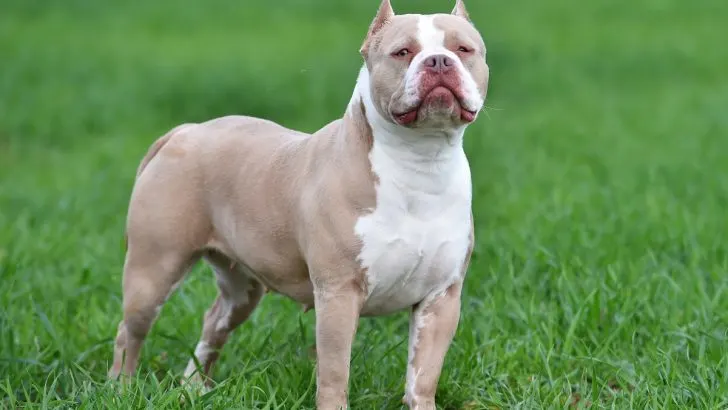Have you noticed bald spots on your beloved pooch? This probably has you in panic, worrying Why is my American Bully losing hair all of a sudden?
American Bullies might look tough, but they are, in fact, very delicate. They are prone to several types of skin conditions, many of which can lead to hair loss.
Luckily, most of the time, you can help your dog grow his hair back. However, first, you need to find the underlying cause of the hair loss so you can know how to approach and treat your pup’s issue.
Here are several reasons why is your American Bully losing hair, as well as a few treatment tips and tricks:
1. Allergies
Just like humans, our American Bullies can suffer from various allergies. In fact, some dogs can even be allergic to humans! However, the most common allergens for dogs include mites, pollen, mold, dust, and fleas.
Allergies are one of the most common skin issues in the Bully breed. From XXL Bullies to Pocket Bullies, all are prone to various sorts of allergic reactions.
Most of the time, though, allergies won’t cause hair loss on their own. Instead, they’ll cause itch and discomfort to your pup, who will spend hours upon hours scratching and biting the sore spot. If this scratching continues, it can lead to hair loss or even open wounds.
How To Help
There are several things you can do to help your pup out, but the best way to keep this from happening is to find out what’s causing allergies and whether you can remove them from the dog’s surroundings.
Air filtration can help with pollen, especially during seasonal changes. You might also contact a local veterinarian to give your pooch allergy shots, as it can be challenging to get rid of all the pollen that’s in the air.
Flea preventatives can keep these nasty pests from bothering your pup. Considering how one bite alone can cause all sorts of irritations, you need to try all you can to keep fleas and ticks away. Considering all the diseases ticks can carry, it’s a good idea to do this regardless of allergies.
If your dog is having food allergies, try changing his diet. A hydrolyzed diet has often helped dogs with food allergies, and there are many hypoallergenic dog foods you can try.
Of course, you don’t need to switch to special food immediately unless your pup is having severe issues. Try finding what is causing his allergies first, and then try switching the specific ingredient.
2. Pressure Sores

Is your American Bully getting bald spots in specific areas, such as elbows, knees, and other bony parts of the body? He might be dealing with pressure sores, also known as bedsores or decubitus ulcers.
Pressure sores occur when the bony parts of your dog’s body get in regular contact with hard surfaces. The constant friction and pressure cause the formation of callous, which further leads to skin thickening and, finally, the dog’s hair falling off.
This condition is especially common in obese dogs, large dog breeds, as well as senior dogs. Older American Bullies are especially prone to them.
How To Help
One of the main culprits behind pressure sores is a hard bed or other surface your pooch loves spending time on. Considering how senior Bullies love to spend most of their days as couch potatoes, it’s easy to see why this health problem is pretty common.
Consider buying a different dog bed, one that is softer on the dog’s body. Maybe even invest that additional money and buy your pup an orthopedic bed. This can not only improve his bald patches but also help with many other disorders, such as hip dysplasia.
You can take a piece of cloth and cover the bony parts of the dog’s body, such as knees and elbows. This can keep them from experiencing constant friction and protect them.
There are also special compression sleeves that you can put on your dog to keep his body and the affected area safe.
Finally, you can also try to keep your dog from lying too long in one spot. However, no one can monitor their dog for so long and be with him 24/7, so I am personally against this method.
Sure, in theory, this might even be the best prevention, but it’s hardly doable.
3. Infections
Other common health issues all types of Bullies, from Micro to Standard American Bully, are prone to include various types of infections.
Some infections and infestations that can cause hair loss are usually caused by ringworm fungus, parasites, mange mites, ticks, fleas, and bacteria.
This can further complicate everything if your pooch is allergic to some of these parasites, which is often the case in sensitive pups such as American Bullies.
Most of these infections are especially prevalent during spring and summer, as parasites and microorganisms thrive in warm weather. Also, since warm and humid conditions help them breed, they love your dog’s skin so much!
Most of these infections will, in severe cases, cause hair loss on their own. Once again, the biggest problem is the itch they cause, making your pup scratch and create open wounds.
Unfortunately, many vets will wrongly diagnose infections as allergies, as the two do have some similar symptoms. This will result in improper treatment, which can sometimes cause more harm than good.
One of the ways you can check whether infections are a possible culprit is to smell your pooch. If he smells like corn chips or Fritos and has bald spots, chances are high that a fungal infection is the culprit.
How To Help
If you suspect your pup has problems with infections, the safest option is to take him to the vet, who will conduct the necessary tests, typically on blood samples, and determine exactly what your American Bully is struggling with.
You cannot treat most infections on your own. This is something that requires veterinary help.
Fortunately, the treatment is usually pretty straightforward. The vet will prescribe topical treatment or antibiotics that you’ll have to administer according to his instructions. The hair will start growing again once your pup has fully recovered.
4. Alopecia

Another reason why your pooch might be losing hair is due to alopecia.
In general, alopecia is any type of hair loss, whether partial or total. However, I am now talking about two health conditions, seasonal flank alopecia and color dilution alopecia.
Seasonal flank alopecia is one of the common causes of bald spots in American Bullies. It typically occurs in winter, during weather and environmental changes, and it leads to hair loss without any other symptoms.
It is unknown what causes seasonal alopecia, but it is supposed to be related to hormonal changes.
Most of the time, your Bully will lose hair symmetrically on his flanks. The exposed skin will be darker than normal, which is another easily differentiated sign of this condition.
Color dilution alopecia, also known as the blue dog disease, occurs in dogs with the dilution gene. American Bullies are some of the most colorful breeds, and blue is a common coat color. However, blue is also known to be the most commonly related to this type of health condition.
Color dilution alopecia causes flaky skin and hair loss in dogs. It isn’t exactly known what is the exact cause, but there is a specific genetic component to it, as it is hereditary.
How To Help
In many cases, both of these alopecias will go on their own. This is especially the case in seasonal flank alopecia, which will typically go away once the weather becomes warm.
Seasonal flank alopecia is purely a cosmetic issue, so many vets will be against using any type of medication. It won’t leave scars, and the hair will regrow.
If any medication is necessary, vets will typically prescribe melatonin.
When it comes to color dilution alopecia, while it can go on its own, many vets suggest regular grooming and bathing with special shampoos to protect the dog’s skin from further damage.
Omega-3 fatty acids are good supplements for this condition as well, as they can improve a dog’s hair and skin quality.
The vet might also prescribe oral antibiotics and other forms of treatments to further treat this condition.
Finally, Bullies with both types of alopecia need to be protected from environmental triggers. Sudden weather changes, harsh sun, and even playing in dust can further aggravate the skin, making the condition worse.
5. Other Health Conditions
Lastly, there are numerous other health problems that can cause hair loss, such as:
- Cushing’s disease, a dangerous health condition caused by an excessive amount of the stress hormone cortisol.
- Demodectic mange, an infectious disease common in kennels and abandoned dogs.
- Sarcoptic mange, a mange caused by mites.
- Hypothyroidism, a disease caused when the thyroid gland doesn’t produce enough thyroid hormone.
Some of these diseases are passed on from other pets and parasites, while others are inherited.
How To Help
All of these medical conditions need veterinary help. The only way to help your Bully is to take him to the vet as soon as possible to prevent worsening of the symptoms.
Some dogs are born bald, such as Mexican Hairless dogs and Chinese Crested. However, when you have a Pitbull, you will probably end up with a huge question mark above your head. Why is my American Bully losing hair?
The only way to truly understand the underlying issue is to contact an expert who will know to look into all the symptoms and find out the cause.
And don’t worry – in almost all cases, your Bully will grow all of his hair back. All you need to do is to give him some additional care to protect him until his coat returns to its full glory.

Vanja’s passion for writing started at an early age, which is why she pursued Journalism as her college degree. She can research any topic and find all the information before you bat an eye, which is a great thing for her job but a terrible one for her husband.
Even as a young child, she fell in love with everything fluffy – but dogs have a special place in her heart due to her childhood companion, a Corgie named Archie.
Motivated by her experiences and driven by a desire to give back to her four-legged companions, she spends her free time volunteering at a local dog shelter.
